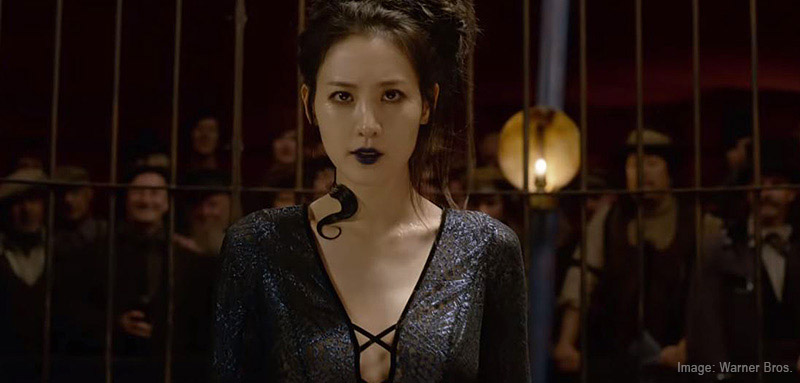The Trouble with Nagini: Accusations of Racism in the New "Fantastic Beasts"
Authors Ellen Oh and Grace Lin discuss their objection to casting an Asian woman as Nagini in the new Fantastic Beasts: The Crimes of Grindewald.

When the trailer for Fantastic Beasts: The Crimes of Grindewald was released this week, a big reveal in the Harry Potter universe became an even bigger controversy, prompting a discussion about racial stereotypes and representation.
The trailer divulges the previously unknown backstory of Voldemort’s pet snake, Nagini, who, as it turns out, was actually a cursed woman who eventually turns into a snake forever. South Korean actress Claudia Kim was cast in the role for the film, and many believe that decision was, at best, misguided and, at worst, racist.
“I don’t know why someone didn’t take a moment to think, ‘Wow, so you’re basically saying the only East Asian woman in Fantastic Beasts is the woman who is destined to become not human anymore—a snake that will be a pet and a vessel for an evil white man and who will be milked and then beheaded,’” says middle grade and YA author Ellen Oh, who was outspoken about the movie on Twitter when the trailer was released. “Is that a good look, when you don’t have much East Asian representation to begin with? I just felt heartbroken.”
 |
Ellen OhPhoto credit: Robin Shotola |
Fellow author Grace Lin says that her first reaction was “disbelief.” To understand why this is such a big deal, one must put it in context, she adds.
"In isolation, the story of Nagini is just an interesting subplot in the Harry Potter universe,” says the author and illustrator of A Big Mooncake for Little Star, The Ugly Vegetables, and other children’s books. “However, because the world of Harry Potter is such a huge part of our culture, it can't be read in isolation.
“The truth is, our culture constantly fetishizes Asian women as either dragon-lady-reptilian sex creatures or as docile, subservient beings eager to do a man's bidding. So to have one of the very few Asian characters in the Harry Potter universe be turned into a snake that becomes a man's pet—it reinforces both of those harmful tropes, and that is actually dangerous to Asian girls and women.”
Harry Potter creator J.K. Rowling responded to the accusations of racist casting on Twitter with a lesson in mythology:
“The Naga are snake-like mythical creatures of Indonesian mythology, hence the name ‘Nagini,’” she wrote. “They are sometimes depicted as winged, sometimes as half-human, half-snake. Indonesia comprises a few hundred ethnic groups, including Javanese, Chinese and Betawi.”
 |
Grace LinPhoto credit: Alan Bradley |
Rowling wasn’t the only one defending the decision. “Harry Potter” fans took to social media to blast the accusations of racism, some appearing to believe that any suggestion of a mistake or flaw in the beloved series of books and films was a call to remove them from our shelves, theaters, and culture completely.
“We always fall into this idea of criticism as censorship,” Oh says. “I’ve never understood how people can make that leap. … The problem is people take it personally—not just the creator but the fans. Taking things so personally leads them to not see things clearly.”
It becomes not about the book, movie, or specific issue at all but about the fans themselves, Lin adds. “When it comes to stories, especially the scope of Harry Potter, it becomes a part of their identity—something that helped make them who they are,” she says. “So when the story is criticized, they think it's a judgement on their own persons.”
Neither Lin nor Oh are suggesting anyone stop reading the books. Despite the flaws, Oh remains a fan of the “Harry Potter” series.
“I’ve reread ‘Harry Potter’ several times,” she says. “I still love the books. They still hold up to me, even as problematic as they can be.”
The issues have often come with Rowling’s additions outside of the “original canon,” like Fantastic Beasts. Those problems are often magnified in the films, Oh says.
“It’s become a very visual representation and it makes the lack of it all the more glaring,” she says.
None of the criticism is a complete condemnation of Rowling as a person or writer. “I have the greatest respect for J.K. Rowling, and I have no doubt she probably had the best of intentions,” says Lin. “That said, the impact is opposite of her intentions.”
Oh hopes this time Rowling takes it to heart and, next time, thinks a bit more. “I’ve always greatly admired her, but she’s human and she makes mistakes and is sometimes not able to see why people are pushing back at her so greatly,” she says. “It’s not because they hate her or think she’s terrible. I know I don’t. I admire her. I really respect her. I wish she’d do better. That’s it.”
For librarians, educators, or parents discussing the published screenplay or movie with children, Lin recommends asking questions and allowing them to guide the conversation.
“To my daughter, I would say, ‘It really bothers me that Nagini was an Asian woman. Did it bother you? I think it bothered me because some people have ideas about Asian women that aren't true,’” says Lin. “And I would go from there. In an educator situation, I would suggest asking students why they think Nagini was an Asian women vs. another race, and talk about stereotypes.”
RELATED
The job outlook in 2030: Librarians will be in demand
The job outlook in 2030: Librarians will be in demand
ALREADY A SUBSCRIBER? LOG IN
We are currently offering this content for free. Sign up now to activate your personal profile, where you can save articles for future viewing






Add Comment :-
Be the first reader to comment.
Comment Policy:
Comment should not be empty !!!